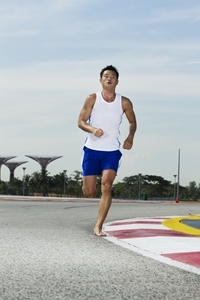Those on travel physical therapy assignments may be asked whether or not running barefoot is OK. In the last few years, barefoot running, also known as minimalism or natural running, has been put under the microscope. The massive lawsuit of Vibram FiveFingers, the running "glove" for feet, only further tightened the focus on the issue.
The debate
Minimalist runners argue that barefoot running is the "natural" way and can correct form by strengthening feet and reducing injuries. According to these proponents, barefoot running forces the runner to fore-strike, or land on the front of the foot, as opposed to heel-strike, landing on the heel, which is potentially caused by the modern running shoe's elevated, cushioned heel.
Those who prefer running with modern running shoes point out that risks of the barefoot method outweigh the rewards. In a time when many of us jog on sidewalks, gravel roads or pavement, we face an increased risk of scrapes, cuts and other damages to the feet. This may be a point of information for travel physical therapist to share with their patients.
So far, there remains a lack of conclusive evidence bolstering or refuting the proposed advantages of barefoot running.
On impact
Studies have shown that barefoot running forces the foot to impact the ground differently. Typically, running shoes make runners strike the ground with their heels first, since the more minimal a shoe, the more the foot, ankle and lower leg have to work to maintain and support the body in motion. Conversely, barefoot running is believed to place the emphasis on the forefoot strike.
The basic premise is that a forefoot strike, associated with flatter foot placement at touchdown, greater knee flexion angle on impact and greater plantarflexion, distributes the impact force across a greater surface area than the heel alone, thus cushioning the impact.
However, a recent Plos One study indicated that about 72 percent of the barefoot population lands on their heels at their preferred running speed. As running speed increased, footstrike shifted toward the forefoot, though 40 percent still struck their heel. During a marathon or half marathon, nearly 90 percent of runners are rearfoot strikers. And for those who are naturally rearfoot strikers, barefoot runs can put stress on the Achilles tendon and result in injuries.
Separate research found that runners who habitually rearfoot strike have a higher injury rate of repetitive stress injuries compared with runners who mostly strike on their forefoot.
Conclusion
The best advice? Runner's World Editor-in-Chief, David Willey, summarized it well in his 2011 editorial about barefoot running.
"There's no single answer or prescription that's right for every runner when it comes to footwear and running form," Willey said.
On the whole, the injury prevention potential of barefoot running is complicated by the web of injury factors, with no single one having been identified as causative for the most common running injuries. In reality, although barefoot or minimalist running is a popular topic of discussion, it is not very prevalent among runners.

